PART IV.
THE DISEASES OF SWINE.
The stomach and digestive organs of swine and dogs,
says Dun, much resemble those of man and are acted on
in nearly the same way by most drugs. The best purge
for swine is three or four ounces of Epsom salt, or a
like quantity of linseed or castor oil, given in a shallow
spoon or bottle. An assistant should hold the animal
firmly by the ears. From two to five drams of aloes is
also a good purge, but it takes from twelve to fifteen
hours to operate. Also one to three drams of jalap, but
large doses may cause nausea or even vomiting. Five to
ten drops of croton oil is a prompt and effectual drastic
purge, but requires, as in most other patients, to be used
with much caution.
To be healthy, swine (in herds) should be kept in large
fields or inclosures, and be provided with grass, pure,
running water, and shade, especially in summer. Corn
and other fattening foods are good for winter. Careful
feeding, breeding, and management are very important
factors in swine rearing, more important perhaps than all
the medicines combined. Still simple disorders may be
successfully treated.
Unlike cattle and sheep, the pig has but one stomach,
which is nearly as simple in structure as that of the
horse. Its teeth are adapted to the mastication of many
kinds of food. The tushes are formidable weapons.
322 THE DISEASES OF SWINE.
SWINE PLAGUE OR SWINE ANTHRAX,
Also known as hog cholera, red soldier, blue sickness,
measles, erysipelas, intestinal fever, typhoid fever, &c., is
a highly contagious and infective disease. It has a period
of incubation, after inoculation, of about five days, when
the temperature is 104 or 106°, succeeded by signs of
general ill health and usually a rash on the skin. It is
epizootic, and is the most fatal swine disease. Pigs dif-
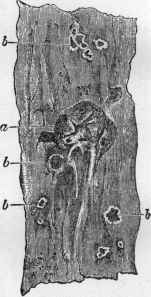
Fig. 157. Part of eæcum (blind gut). a, ilio-cæcal opening. b, b, b,
ulcers in various stages.
fer in their susceptibility to it. It appears to be caused
by contagion or infection only, no amount of misman
agement, filth, lack of drainage, or decomposing food
being sufficient to induce it. (Williams.)
SWINE PLAGUE.
323
Symptoms.—Loss of appetite ; general prostration;
small and frequent pulse ; hanging ears ; sullen appear
ance ; painful and haggard expression ; watery eyes, the
conjunctive membranes being red and spotted ; dirty se
cretion about the eyelids, usually preceded by a red blush
and red spots on the ears, the abdomen, and internal as
pects of the extremities. The reddened spots are at first
hot and painful to the touch, but become cold, humid,
and insensible even to the pricking of a pin. As the
disease advances trembling and convulsions are manifest
ed ; grinds the teeth ; flexor muscles of limbs contract ;
stands on toes. These symptoms are succeeded by paral
ysis of the posterior extremities, or of the whole body,
involuntary defacation (bowel evacuation), and high col
ored and even bloody urine. The bowels are at first gen
erally torpid, but the feces may be soft and mixed with
very black, fetid blood and thick, tenacious mucus. Di
arrhea, however, often sets in ; the evacuations are then
profuse and exhaustive ; the breathing becomes catching
and convulsive ; a painful cough is present ; the convul
sions increase in violence and may continue to do so till
the end ; but sometimes the animal becomes comatose and
remains so till the end.
In some cases the first observable symptoms remain
stationary from 24 to 48 hours ; then the surface of the
body becomes burning hot and very sensitive to the touch,
notably at the sides and abdominal walls. If touched,
the animal cries with pain. To these signs are added
trembling, convulsions, grinding of the teeth, and tetanic
(tetanus or lockjaw-like) contraction of the muscles, suc
ceeded by rapid diminution of temperature. The mem
branes of the eyes become brown, the eyes themselves
bleared ; tongue dirty, thick, bluish ; the animal, ex
tended on its litter, is incapable of any regulated move
ment, and dies in from 24 to 48 hours.
These symptoms are liable to various modifications, de-
324 THE DISEASES OF SWNE.
pending on the intensity of the fever and the locality
of the poison. In some cases the virus seems to expend
itself on the serous membranes, causing either inflamma
tion of the peritoneum or pleurisy ; sometimes on the
mucous membranes, as shown by bronchitis or broncho-
pneumonic congestion and hemorrhage, and enteric (in
testinal) congestion and ulceration ; sometimes even to
perforation or rupture of the bowel.
In many cases the animal is amaurotic ; wanders to
and fro ; falls, rolls, kicks. Now and then it will rise
from its bed and give a piercing cry, the whole body be
ing involuntarily convulsed. (Williams.)
Dr. H. J. Ditmers says swine plague “is not a single
or separate disease, but rather a group of several kindred
diseases, similar to each other in regard to causes, mor
bid process, contagiousness, and final termination, but
differing very much as to symptoms, seat of morbid pro
cess, course, and duration.”
Swine plague is classed among the incurable diseases.
APOPLEXY
Occurs usually in ‘fat hogs. Several forms have been
described, but all are chiefly caused perhaps by too much
blood and confinement—lack of exercise. The specific
blood poison of anthrax may not be present. The dis
eases of pigs to which the term apoplexy is applied, how
ever, partake more of the nature of anthrax than other
wise, especielly in young and growing animals.
Symptoms.—Restlessness ; eyes bloodshot; appetite
variable; constipation; dung and urine scanty. As the
animal eats, it suddenly stops, reels, and falls down dead,
a great quantity of foam issuing from the mouth.
Remedy.—As apoplexy is a most fatal complaint,
prompt preventive measures should be instituted on its
first appearance. Place healthy swine on a low diet;
exercise; cleanliness. Give Epsom salt, 2 to 4 oz., cal-
BLEED FOR APOPLEXY.
325
omel, 3 to 10 grains, ginger, 2 to 3 drams, with molasses
and linseed mucilage in proportion—immediately. Give
same dose to sick hog, that is, if it does not die too soon.
Clysters for constipation. When down and breathing
heavily, bleed from the veins of the inner surface of the
ears. The palate veins and also those of the fore limbs
may be opened if necessary.
EPILEPSY
Prevails more among swine than among either cattle
or sheep. Its exact nature is not understood further than
that it depends on some peculiar morbid condition of the
nervous system, probably degeneration of tissue, arising
from defective nutrition ; also on remote causes, such as
abscesses, tumors, &c., in the spleen, brain, and other
organs ; worms in the stomach or intestines, and other
conditions producing reflex action. It is peculiar to young
animals generally, but it occurs in the old also as a result
of blood diseases, blood poisoning, &c. It is rarely curable.
Symptoms.—Severe convulsions, with coma (sleepiness)
and foaming at the mouth ; staggers ; eyes protrude and
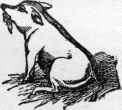
Fig. 158. Epilepsy.
stare ; violent champing of teeth ; drops on haunches ;
fore limbs rigid ; head elevated, turned \from side to side
rapidly and now and then tossed up ; muscles convulsed ;
urine and feces pass involuntarily ; tongue bitten ; falls,
struggles violently, and soon becomes unconscious ; heart
326 THE DISEASES OF SWINE.
beats strong ; membranes increased in color. A long
sleep may follow, or the animal may soon regain con
sciousness, but only to be speedily reattacked ; dies.
Remedy.—If caused by nervous disorder, give bella
donna or atrophine. If from worms, give a vermifuge.
Proper food and housing ; exercise. At the time of attack
little can be done. Dashing cold water over the head
and face is the most proper course, deferring other mea
sures till the seizure has passed. Strychnine, quassia,
gentian or other tonic for lack of blood ; less nutritious
diet for too much blood ; also exercise. As a means of
reducing the severity of an attack, and while there is
power to swallow, chloroform, chloric or sulphuric ether,
chloral hydrate, &c., should be given, or the animal may
inhale the first, the latter being injected beneath the skin.
When it is known that a nerve is at fault, it may be
divided, or the firing-iron may be applied over the locality.
For doses, see pages 13 to 29.
TRICHINA SPIRALIS (WORMS),
According to Williams, is usually found within capsules
or cysts, occupying the muscles of some animals, such
as the pig, or even of man. When full-grown, the female
is much larger than the male, being one-eighth and one-
eighteenth of an inch in length respectively.
Small animals, such as rats, cats, and rabbits, when
seriously infected, like man, soon succumb to the disease.
The health of larger animals, however, is rarely affected.
A pig that was experimented on in the Royal Veterinary
College, showed no signs of the disease, notwithstanding
an after-death examination indicated that its flesh prob
ably contained 16,000,000 of living worms ! Other pigs,
however, showed much general disturbance and suffering,
arising from the irritation of the worms in the intestines
and during their passage into the muscular tissue. The
irritation of the alimentary canal, which lessens toward
COOK PORK WELL.
327
the end of the first week after pigs have swallowed trich
inæ, is denoted by loss of appetite, vomiting, colic, diar
rhea, dullness, arching of the back, and an inclination
to lie down and hide in the litter. These symptoms, ex
cept the diarrhea, usually disappear in from six to eight
days.
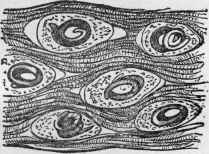
Fig. 159. Pork Flesh Worm (Trichina Spiralis), imbedded in the flesh.

Fig. 160. The immature worm, highly magnified.
When the trichinæ are numerous, the membranous pas
sage of a great number of them induce in some pigs a
fatal inflammation of the peritoneum ; in others a form
of inflammation of the intestines, with ejection of false
membrane.
Trichinous pork, if used at all, must be well cooked.
Great heat is necessary to kill all the worms. The only
safe plan is to cook all pork meat thoroughly.
328 THE DISEASES OF SWINE.
MEASLES
In swine, cattle, or sheep means an internal or intra
muscular disorder, not an external eruptive disease. It
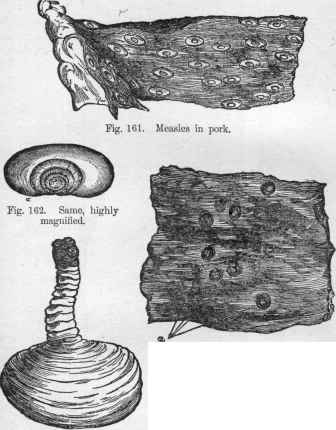
Fig. 163. Slice of roasted sirloin beef.
a, measles divided by knife into
nearly equal parts.
Fig. 164. Measle or Bladder Worm
of beef. Magnified.
is caused by a tapeworm technically known as ‘ Tænia
solium’ (solitary tapeworm), which imbeds itself in the
WHAT MAY CAUSE TAPEWORM.
329
flesh. The eggs of the worm are taken up by the pig in
its search for food here and there, especially among dung
heaps and other filth. The worm is nearly spheroidal in
shape, having an average diameter of about 1-694th of an
inch, and therefore readily enters the circulation, whence
it is carried to various parts of the body. It is very pro
lific It lives about two years and produces at least 1,600
joints, each of which contains 53,000 eggs—total, 85,000,-
000. Fortunately, like the ova of other parasites, many
are destroyed in various ways.
After the ova enter the flesh, several changes occur.
The germs are inclosed in small cysts or bladders, each

Fig. 165. Larva of Pork Tapeworm, Fig. 166. Head of Tænia Solium
with caudal vesicle, liberated or Pork Tapeworm,
from cyst. Hooks at top.
having a small, rudimentary head, with hooks and suck
ers, &c. They remain in the body till the pig is slaugh
tered, when, if the pork is not thoroughly cooked, they
produce full-grown tapeworms. An unusually large num
ber of them may kill a hog. They are peculiar to the
330
THE DISEASES OF SWINE.
tender flesh of young animals, being unable to enter the
solid flesh of those even one year old. (Armitage.)
Prevention.—Feed swine on healthy food.
PROTRUSION OF THE RECTUM
Is common. The causes are violent straining during
constipation, diarrhea, impaction of the stomach, worms,
piles, and injuries inflicted in the anus or intestine ; it
may also follow difficult parturition and stitching across
the vulva to prevent eversion of the uterus or bladder.
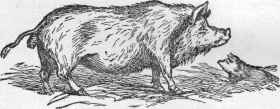
Fig. 167. Protrusion of the Rectum.
Remedy.—When recent, the color bright, and the tu
mor of moderate dimensions, merely wash parts gently
with warm water, the whole carefully compressed at the
sides by the fingers, which are spread so as to include as
much of the tumor as possible. By a kneading move
ment, in which the thumbs should be especially active,
the central part gradually returns, followed by the outer,
until the whole is replaced. Subsequent straining is to
be checked—when not caused by constipation—by a full
dose of opium or chloroform, chloric ether, &c., and in
jections of the same fluids may be required. When con
stipation is the cause, purgatives should be given, com
bined with anodynes. Change food if necessary. Some
times the organ is protruded six or seven inches, is greatly
swollen, and now and then lacerated by being seized by
other pigs. Foment for two hours or more, and if nee.
REMEDY FOR CONSTIPATION. 331
essary apply ice, astringents, &c. In other cases, when
time has elapsed, the organ may be livid or dark purple
in color and injured by the movements of the patient.
Treat as above and recovery often follows. The cause
of the protrusion must be ascertained and removed be
fore a permanent cure can be effected. (Armitage.)
CONSTIPATION
Is caused by the excessive use of highly stimulating
food and lack of exercise.
Symptoms.—Dull ; refuses food ; avoids companions,
even hiding in the straw or in a dark corner of the stye ;
is obstinate, even bearing punishment before rising ; walks
crampy, grunting or screaming ; anus clean and firmly
contracted ; belly tender, pressure on which causing the
animal to scream, rush away, and crouch at a distance ;

Fig. 168. Usual position when suffering from Constipation
the invariable position is as shown above (Fig. 168) ;
pulse rapid, full, hard ; membranes injected ; abdominal
pain ; up and down, screaming or grunting ; urine de
ficient, high colored, ammoniacal. If not relieved, the
symptoms increase in severity ; becomes frantic ; apoplexy
may end life. Sometimes the abdominal pains increase,
diarrhea ensues, and the animal dies in from 12 to 24
hours of prostration.
Remedy.—Purge early with Epsom salt, 2 to 4 oz.,
powdered ginger, 1 dram, powdered gentian, 2 drams,
calomel, 5 to 10 grains, mixed in linseed mucilage. In
jections of soap and warm water every half hour. In 2
332
THE DISEASES OF SWINE.
hours after giving the internal dose, give the following
stimulant : Spirit nitric ether, 2 to 4 drams, essence of
ginger, ½ dram, tincture of belladonna, 1 dram, in a half
pint of warm linseed tea. Friction to skin ; general com
fort. Laxative food at first, in sparing quantities and at
regular intervals. Drink, tepid water, with a small quan
tity of oatmeal, linseed tea, &c. Let animal roam. Care
ful attention to food to prevent another attack. (Armi-
tage.)
SCROTAL RUPTURE (HERNIA),
Is very common among young pigs, and such should
be castrated by the covered operation. The general prac
tice is to castrate in the usual way and stitch the divided
scrotum. Sometimes castrators include the intestine in
the suture, causing death. I have cut pigs with hernia
by merely inclosing the scrotum in a loop of twine—first
returning the intestine—and allowing the parts to be re
moved by sloughing ; and they have done well. Pigs are
peculiarly liable, during some seasons, to suffer from te
tanus (so-called lock-jaw) after castration. (Williams.)
CATARRH
Is the same in nature in swine as in other animals, and
should be treated the same. Give laxatives in warm
mashes, and protect from exposure to cold, dampness, and
drafts. (See pages 70 and 258.)
DIARRHEA,
Which usually attacks sucking pigs, should be treated
on the same general principles as diarrhea in other ani
mals. The dose must be small for young pigs, and is
best given in a shallow spoon or bottle, but for older an
imals it may be mixed in a dainty dish. In sucking pigs
see that the sow has healthy food ; in fact, look to the
food in every case. (See pages 107, 246).
A VALUABLE LINIMENT.
333
PARALYSIS OF HIND QUARTERS
Is not common, but it should be combated with care
and suitable remedies. Simple turpentine rubbed over
the loins and back sometimes gives relief. If it fails, rub
with the following penetrating linimen t: Alcohol, 1 pint,
ammonia, ¼ oz., oil organum, ½ oz., oil sassafras, ½ oz.,
tincture opium, ¼ oz., tincture capsicum, ½ oz., oil tur
pentine, ½ oz., camphor, ¼ oz. A teaspoonful of this lini
ment, diluted with a wine-glass of water, will check di
arrhea or colic in man as well as the lower animals. Re
peat dose if necessary. Horses and cattle would require
about ½ an oz. internally for colic ; water in proportion.
RHEUMATISM
Should be treated with the above liniment, or some
other equally soothing and penetrating. Give gentle lax
ative in food if necessary, and keep swine in warm, dry
quarters.
INFLAMMATION OF THE LUNGS (PNEUMO
NIA),
Also called heaves, thumps, &c., is a dangerous and
usually incurable disease. (See pages 79, 261.)
QUINSY
Is an inflammation of the throat and adjacent parts,
accompanied by more or less fever. It is similar to if
not the same as laryngitis (sore throat). Apply warm
fomentations and rub with soothing liniments. If exter
nal suppuration takes place, encourage it, and treat it as
a boil. If the animal can swallow, a tablespoonfu1 of
turpentine and oil may be given in swill.
Quinsy, or strangles, as it is sometimes called, on ac
count perhaps of the difficulty of breathing, is a danger
ous disease.
334
THE DISEASES OF SWINE.
MANGE
Is caused by the mite illustrated below (Fig. 169). It
is transmissible to man. (See pages 168, 281, 301.)
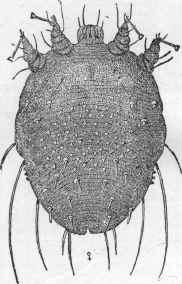
Fig. 169. The mite or acarus known as Sarcoptes suis. Magnified.
For Lice, see pages 168, 284.
For Jaundice, see pages 133, 253.
For Foot and Mouth Disease, see page 224.
For Scrofula or Tuberculosis, see pages 91, 225.
But first, if you want to come back to this web site again, just add it to your bookmarks or favorites now! Then you'll find it easy!
Also, please consider sharing our helpful website with your online friends.
BELOW ARE OUR OTHER HEALTH WEB SITES: |
Copyright © 2000-present Donald Urquhart. All Rights Reserved. All universal rights reserved. Designated trademarks and brands are the property of their respective owners. Use of this Web site constitutes acceptance of our legal disclaimer. | Contact Us | Privacy Policy | About Us |